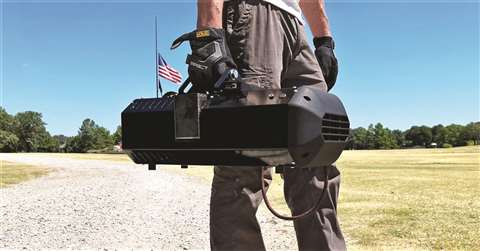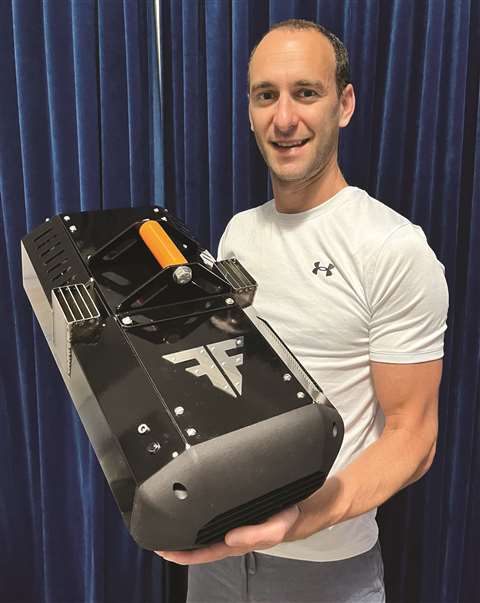FusionFlight microturbine generator packs power in a very small package
22 December 2022
 The ARC’s components are packaged in a compact aluminum and carbon-fiber enclosure that weighs in at 20.7 lb. (Photo: FusionFlight)
The ARC’s components are packaged in a compact aluminum and carbon-fiber enclosure that weighs in at 20.7 lb. (Photo: FusionFlight)
One of the enduring quests for engineers is a simple one: how to deliver the most power in the smallest, lightest package. Now, a Texas company has developed a generator system that can deliver 8 kW while taking up about the same space as a toolbox.
Launched late last year, the ARC microturbine generator from FusionFlight was originally conceived essentially as an alternative power source for drones. But it became clear to company CEO Alex Taits that its high power to weight ratio and compact dimensions made it suitable for a lot of other venues.
“Originally the ARC was developed for large electrical drones to replace the heavy lithium batteries,” Taits said. “This allows the drones to take advantage of the high energy density of kerosene fuel and greatly increase the range/endurance.
“Later it became clear, that the ARC also has great applications as an auxiliary power unit (APU) for large fuel-based aircraft or as emergency power source during natural disasters.”
Microturbine-based
The ARC generator is based on a two-stage microturbine that has a maximum operating speed of 130,000 rpm – too high an input speed for any alternator to handle.
“The ARC utilizes two methods to bring the rpm down,” said Taits. “First, the second-stage turbine is decoupled from the first which provides significant reduction. From there, a state-of-the-art gearbox is used to bring the rpm down to its final value. Liquid fuel is circulated through this gearbox to keep it cool during operation.”
 Alex Taits, CEO of FusionFlight, with the company’s ARC microturbine generator that can deliver 8 kW from a package the size of a toolbox. (Photo: FusionFlight)
Alex Taits, CEO of FusionFlight, with the company’s ARC microturbine generator that can deliver 8 kW from a package the size of a toolbox. (Photo: FusionFlight)
The gearbox outputs to a lightweight, high-performance three-phase brushless alternator that, together with the power electronics, delivers 8 kW of 25 to 84 V dc power to two M6 terminals connections. For higher power requirements, multiple generators can be paralleled, the company said.
In addition, FusionFlight offers several types of external electronic modules, including step-down and step-up regulators and inverters to drive different kinds of ac loads, such as standard household devices. The inverter can also be coupled with a charger and used as a range extender for electric vehicles, Taits said.
The unit incorporates a brushless starter motor that is powered by a compact lithium-iron phosphate battery. Once the ARC has reached operating speed, the battery is recharged using built-in charger circuitry.
The ARC’s components are packaged in an aluminum and carbon-fiber enclosure that measures 20.7 in. long, 10.6 in. wide and 6.61 in. high (510 mm x 270 mm x 168 mm) and weighs in at 20.7 lb. (9 kg).
The ARC generator does not have its own integral fuel tank, but instead uses an onboard fuel module that incorporates pumps and supply and return ports that draw fuel from the user’s remote fuel tanks. “This allows us to build a very compact generator that is highly adaptable for a variety of applications,” Taits noted.
FusionFlight also offers fuel tanks ranging in size from 5 to 105 gal. (20 to 400 L). The unit can operate on a variety of liquid fuels, including diesel, kerosene and Jet-A, mixed with 5% turbo oil for internal lubrication.
Overcoming sound and heat
The ARC microturbine has no integral controls, rather all operating functions can be accessed through a wired removed control or app (see video from FusionFlight below). “The Bluetooth app controls all aspects of the turbine,” Taits said, “including the automatic start sequence, throttling, automatic cool-down as well as all other functions like fuel priming and diagnostics.”
One of the more noticeable aspects of the ARC is that it generates significant sound emissions – 100 dB(A). “The sound level is certainly high,” Taits noted. “But the original applications for the ARC involved mostly aircraft, so this wasn’t a big issue. Using it at home during a power outage seems unlikely due to the noise, but we are currently developing ways to mitigate the noise level and exploring several paths including inlet/exhaust ducting as well as active noise cancellation”
The unit also produces significant heat during operation. “The specially designed exhaust pipes actually mix the turbine exhaust with atmospheric air to lower the temperatures to roughly 500º C (932º F),” Taits said. “It is still too hot for anybody to touch, but since the ARC can be run remotely, we do not believe this represents a safety issue.
“We also provide custom exhaust ducting solutions to meet customer’s specific applications and safety requirements.”
Sales of the ARC microturbine generator are handled directly through FusionFlight from its headquarters in Dallas.
STAY CONNECTED




Receive the information you need when you need it through our world-leading magazines, newsletters and daily briefings.
POWER SOURCING GUIDE
The trusted reference and buyer’s guide for 83 years
The original “desktop search engine,” guiding nearly 10,000 users in more than 90 countries it is the primary reference for specifications and details on all the components that go into engine systems.
Visit Now
CONNECT WITH THE TEAM









